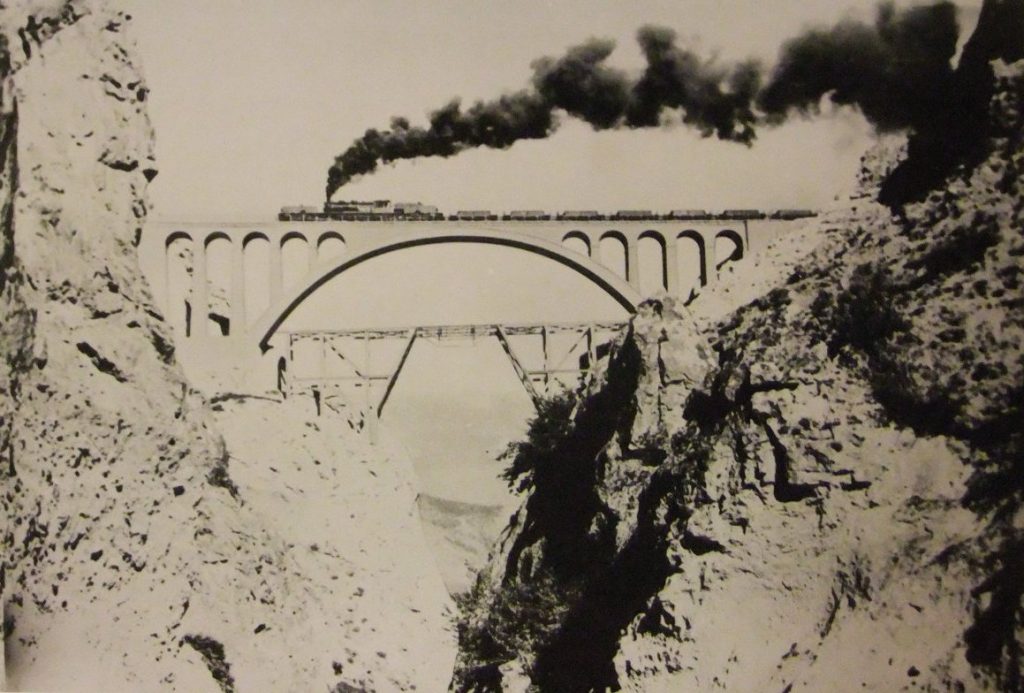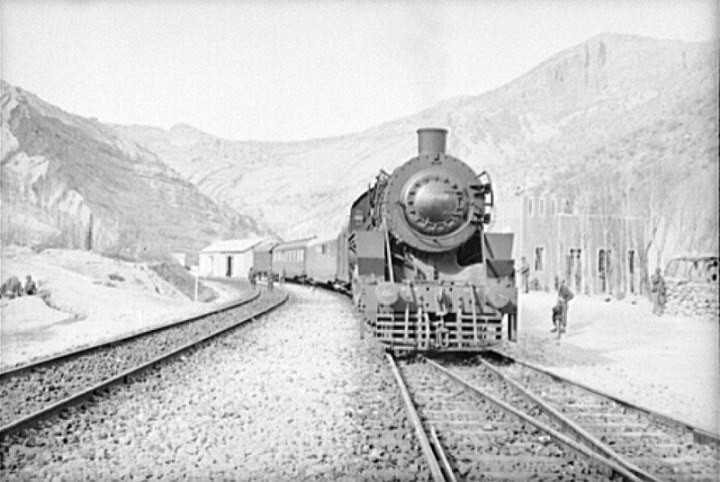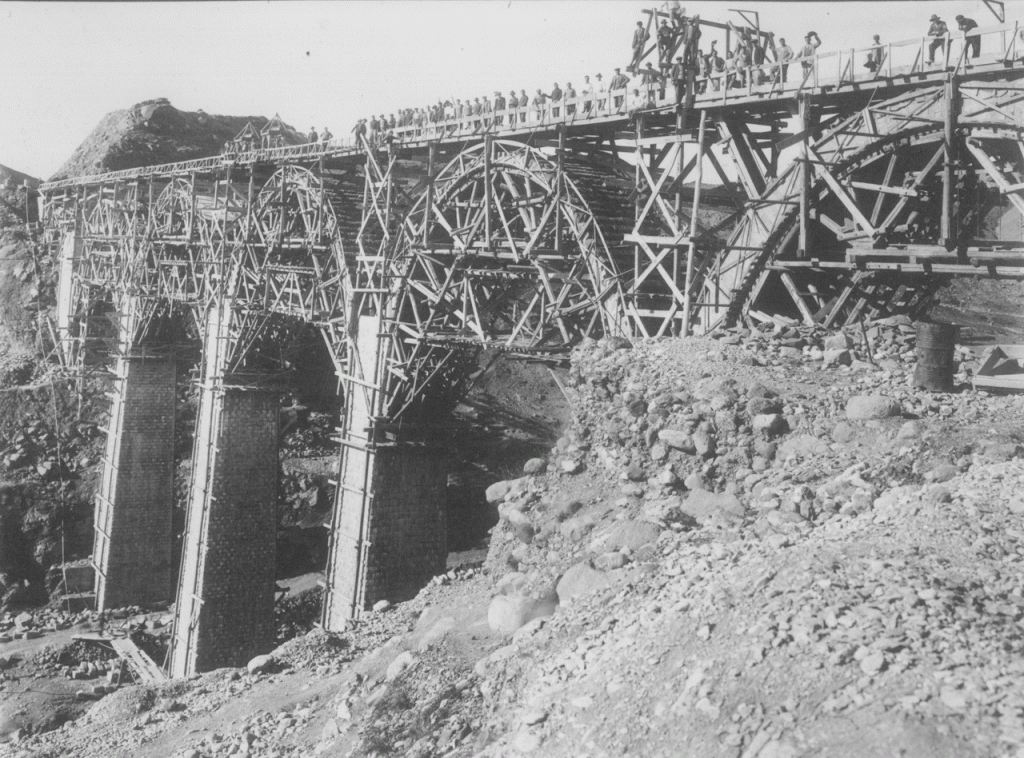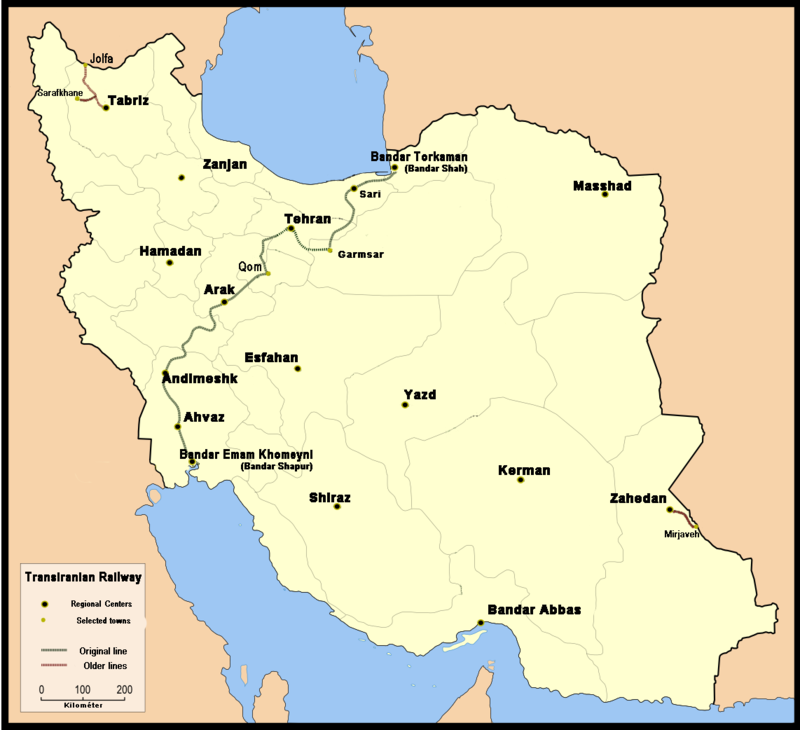Emerging Scholarship is a series showcasing the research and interests of new voices emerging from academia that focus on the social worlds, histories, and traveling cultures of Central and West Asia.
Mikiya Koyagi is an Assistant Professor of Middle Eastern and Islamic Studies at New York University. His current research examines the impact of transportation technology on various segments of Iranian society such as nomads, laborers, pilgrims and tourists from the mid-nineteenth to the mid-twentieth century. Aside from research agendas within Iranian Studies, he also studies relations between Japan and the Islamic world since the mid-nineteenth century.
He recently defended his dissertation, “Mobilizing Iran: Experiences of the Trans-Iranian Railway, 1850-1950” at the University of Texas Austin. His recent publication “The Vernacular Journey: Railway Travelers in Early Pahlavi Iran, 1925-1950,” is featured in the October 2015 issue of the International Journal of Middle East Studies.
1) AjamMC: Hello, and welcome to another installment of Ajam Media Collective’s Emerging Scholarship Series. I’m Rustin Zarkar, and today I am here with Mikiya Koyagi, an Assistant Professor at New York University’s Department of Middle Eastern and Islamic Studies. It’s a pleasure to have you here MIkiya.
Your latest research project focuses on the Trans-Iranian Railroad and its role in promoting particular notions of public space and society in Iran. Before we get into the details of these social transformations, could you give us a brief introduction as to the history of the railway in Iran? When and how was is it built?
MK: The Trans-Iranian railway was the first extensive railway that was built in Iran to connect the new port of Bandar-e Shah (now Bandar-e Torkaman) on the Caspian Sea with another new port called Bandar-e Shahpur (now Bandar-e Imam Khomeini) on the Persian Gulf. So it was a railway to connect Northern Iran with Southern Iran via Tehran, the capital. And there are two unusual characteristics about the Trans-Iranian railway project:
- The railway was built between 1927 and 1938. 1938 is the pretty late for railway construction compared to places like India and Egypt, which had railroad systems in the 1850s. Iran’s railway project began almost an eighty years later. The late arrival of the railway technology impacted various aspects of how the railway and the broad segment of Iranian society interacted.

The route of the Trans-Iranian railway. Credit: Wikimedia Commons Unlike many other railroads in Asia and Africa, the Trans-Iranian Railway was built by the centralizing Pahlavi state and not by a colonial power or private company. It was partially funded by heavy taxes on tea and sugar. The Pahlavi state initially had a contract with a German-American consortium to build the railroad, which was then cancelled. Eventually, the railroad was built under the supervision of a Danish consortium called Kampsax, which had experience with railway projects in places like Turkey.
These are the two unusual features of the Trans-Iranian Railway that I’m working on.
2) AjamMC: That’s fascinating, especially the railway’s relative lateness in comparison to neighboring regions like India, Egypt, and Iraq. Why this was the case? Why do we see railroads in the 19th century these countries? Obviously there are differing colonial experiences than in Iran, but what was the primary reasons for such lateness and how did it affect the perceived utility and the power of the railroad?
MK: There are several factors involved. First of all, the Qajar state did not have enough wealth to construct its own railway. In fact, there really was not an idea among a lot of Iranian railway advocates of the Qajar era that the railway should be built by the state. So, they saw it more as a private enterprise, but they were unable to collect sufficient capital to construct a railroad either.
The major obstacle came from the fact that Iran was a buffer state between the Russian Empire in the north and the British Empire in the south and east. Often times, Naser al-Din Shah (the ruler of Iran in the second half of the 19th century) was pressured to balance out these two powers, which meant granting similar concessions to citizens of both empires. So if you give a concession to a citizen of the British Empire, you then needed to give a similar one to a Russian citizen. in the 1880s, the competition for railway construction was becoming pretty intense between the Russian and British Empires.
Ultimately, Russia decided that rather than having both Russian and British-built railways in Iran, it was better to have no railway at all. It was a way to protect what Russia considered as the Russian sphere of influence in northern Iran. This central fear was that the British might enter into the northern Iranian market and jeopardize Russian commercial advantages in the area. So in 1889, the Russian government signed an agreement with Naser al-Din Shah to ban railway construction in Iran for ten years. This agreement was later extended for another ten years. By the time the agreement expired, World War I broke out. These are some of the major reasons why Iran didn’t have a railway before 1927.

3) AjamMC: This fits directly into the standard narratives we hear about the Great Game, in relation to Iran vis a vis Russia and Britain. Can you give us a brief introduction into the historiography of transportation technologies in Iran and what your project brings to this?
MK: Because it was built by the centralizing Iranian state, a nationalist state that was emerging in the 1920s and 30s, there are three specific historiographical problems:
- The overemphasis on the state itself: state centrism is a generally a problem in modern Iranian historiography, but especially in this case. We know virtually nothing about how various social groups experienced the railway project. All we know comes from state propaganda constructed in the 1920s to 1940s by the Pahlavi state.
- The issue of periodization: we focus so much on the actions of the rest of Reza Shah’s reign, we tend to ignore what happened during the Qajar period, which had a major impact on how Iranians imagined the railway project. We also ignore what came after, during the occupation period that began in 1941. Only three years after the completion of the Trans-Iranian Railway in 1938, Iran was occupied by the Allies. This period in the 1940s is pretty crucial when we think about how the railway was used by various groups.
- The focus on the Iranian nation: the railway was perceived by the Pahlavi state as a nation-building project. Sometimes we ignore the transnational aspects of the project that are crucial to constructing the imagination of the railroad. When we think of other issues like labor and travel, we really can not ignore these aspects that go beyond the national borders of Iran.

4) AjamMC: I want to come back to the basic logistics of this railroad. As you very succinctly describe, the railroad ran from the Caspian Sea, south through the Zagros, into Khuzestan with its terminus at the Persian Gulf. We know that Anzali and Bandar-e Torkaman on the Caspian Coast were major importing areas for Russian and European goods. We also know that the Anglo-Iranian Oil Company was in Khuzestan; they were operating there for about two decades (since 1908). What was the spatial and economic logic to the railroad? What influenced its route? Who did it benefit? You talk about colonial powers, but I’m also interested in other social groups.
MK: We hear a lot about how various political and military calculations of the Pahlavi state impacted the route of the railway in the 1930s. We often look at the necessity to control the oil-rich province of Khuzestan and the need to control various tribes along the route. I think these factors are very important, but at the same time, I think we get a better sense when we look at the Qajar period, and the debates that were going on in the second half of the 19th century. In the Qajar period, there were various proposals for railway routes, both among European entrepreneurs and Qajar railway advocates. They all prefered the north-south line because many of the advocates didn’t necessarily think of it as a state project. Profitability and the economic needs were major considerations.
When we think about the international trade of the 19th century, the Caspian Sea ports were crucial. Iranian travelers leaving Iran would go from Tehran to Anzali, and from there to Baku in the Caucasus, and from there they could travel by train. That was even the case when they were going to Mecca — they would go to the Caspian Sea from Tehran and then cut across the Caucasus to the Black Sea. Having the railway in the Caspian Sea region was a very natural consideration to have, because very few people would go all the way from Tehran to Tabriz (in northwestern Iran), and from there head to Anatolia and the Caucasus — that was not the preferred route.
As for the southern areas, one can ask, “Why not Bushehr?” another major port on the Persian Gulf. If they were to build a railway from Tehran to Bushehr, instead of Bandar-e Shahpur, it would have been twice as long. So there were more realistic and economic considerations that were proposed since the late 19th century, especially during the Constitutional period. Once we get to the early Pahlavi period, we also start seeing more specific political considerations. For example, the port of Muhammareh, present-day Khorramshahr, was excluded from the final plan partly because of its proximity to the Iraqi border, which was considered a security concern by some.
Political, national, and economic considerations all played a role in determining the route of the Trans-Iranian railway.

5) AjamMC: The railway itself created new public spaces, and this really affected Iranian society at large. How did the railway itself affect the daily lives of Iranians?
MK: If I can oversimplify a bit, there are groups that were negatively affected and other groups that benefited from the project. One of the groups that were impacted negatively was landowners. There were a lot of petitions submitted to the Iranian parliament by landowners around Tehran who complained about how their land was confiscated by the Pahlavi state during the initial construction phase. They continued to submit petitions until 1941 and 1942, without any tangible results. Other landowners were negatively affected due to the environmental impact of the railroad. Some of the forests that rural landowners owned were burned, and contractors rarely compensated them. Former rice-cultivating farmers in Mazandaran province (on the Caspian Coast) were also negatively impacted. In order to stop the spread of malaria during construction, rice cultivation was banned in the immediate vicinity of the railway route. Many rice farmers had no option but to join the construction labor force.
The railroad brought the construction of stations, which then encouraged the establishment of new institutions like hotels and teahouses. Nearby villagers started to go to the newly-built stations to sell their agricultural products. There was also a mass exodus of laborers working in road construction sites to moved railway sector because of higher wages. So while there were various types of dislocations, there were new economic opportunities for various groups.
Additionally, there was an influx of foreign workers, which is often ignored in the nationalist historiography. The Danish consortium of Kampsax supervised the construction but did not engage in the construction itself, so there are various contractors from countries like Denmark, Sweden, Hungary, Germany, Switzerland, Italy, and Britain. There are many engineers and managers coming from different European countries coming to Iran. Additionally, skilled workers from Greece, Czechoslovakia, and Turkey also made their way to Iran. Many stayed until the 1940s.

6) AjamMC: One of the biggest advantages of having a railroad is the reduction in travel time. It used to take thirty days to travel to Basra or Baghdad, but following the completion of the railroad it took only fifty hours. This is a substantial difference. How can we talk about mobilities in its relationship to people? What kinds of people were actually using the railroad and for what purpose? Additionally, which people were restricted from the railroad, or had unequal access to it?
MK: When we talk about who used the railway, I think it is important to keep in mind the Allied occupation from 1941 to 1945. When the Allies occupied Iran, they forced Reza Shah to abdicate and then they controlled various transportation routes, including the highways and the railway in order to prioritize the transport of war material from the Persian Gulf to the Soviet Union. A lot of Allied soldiers — British, Indian, and later American — started to use the railway for their movement. You also see the movement of Polish Jewish refugees, which Lior Sternfeld talked about in his interview with Ajam Media Collective. Many used the railway to travel to Palestine.
In any case, the Allies restricted civilian use of the railway, so the number of available seats for Iranian passengers decreased during the occupation. Also, motorized vehicles became increasingly unavailable during the occupation because repair parts for automobiles were diverted for the war effort. Also, when Japan occupied Malaya and the Dutch East Indies, rubber became unavailable, creating a shortage of tires in Iran. All these factors contributed to the perpetually congested Iranian railway space because people had to rely more on locomotive travel as the number of seats decreased.
In terms of who used the railway in this context, the overwhelming majority of passengers in the 1940s were Shi’i pilgrims to Qom, and more importantly to the Shi’i holy cities in Iraq. They travelled by train from Tehran to Ahvaz, from Ahvaz to Basra they used taxis, and then from Basra to Baghdad they once again used the train. It is interesting how the national project of the Trans-Iranian railway facilitated transnational pilgrimage once it opened. Most of the travelers used third or fourth-class cars, which were essentially roofed freight cars without access to water, light, and ventilation.
There was also a small number of tourists or vacationers from the emerging salaried urban middle class. They typically travelled from Tehran to northern Iran, and sometimes even they had to use third-class trains when tickets were unavailable.
The unavailability of tickets was very problematic for villagers travelling to sell their agricultural products. For example, in Firuzkuh county (in northern Iran) that had a population of 30,000 people, the railway organization only sold only four tickets during the occupation. Of course that wasn’t enough, so it forced a lot of villagers to sneak into the trains and become freeloaders. The context of the occupation really impacted the way Iranian travellers could, or could not, use the railway.

7) AjamMC: So Iranians from different walks of life were interacting with one another in the railway space for the first time. In your article, you argue that the railway space becomes “a microcosm of the heterogeneous Iranian nation.” This is in contrast to what many middle-class Iranians wanted the space to become. How did middle-class Iranians envision this space as well as the social interactions within it?
MK: What I call the “railway space” includes places such as stations, platforms, and cars. This space included elements of Iranian society. In the trains, we see foreign passengers, a small number of tourists, hundred of thousands of pilgrims, and freeloaders. On the platforms, especially in rural stations, there were a lot of beggars — particularly in provinces like Luristan which experienced a construction boom in the 1930s. Once the construction ended, a lot of the former laborers turned to begging around the stations, waiting for passengers to give them money and food.
This was very different from what many modern middle class Iranians envisioned, especially before the opening of the railway in 1938. The vision of the railway space they promoted was a more homogeneous space for essentially Europeanized-Iranian citizens who used the railway in order to tour around their homeland. They were Europeanized both in appearance and in behavior. Instead of having religious garments, they had to wear European clothes. As opposed to carrying items that reflected their domestic lives (such as samovars, water pitchers, and jars), they were expected to carry a bag. Rather than eating and making a mess around the sofreh (a piece of clothes placed on the floor during meals), they should sit on seats and behave in an orderly manner. The Iranian railway space was imagined for national citizens with proper behavior, and no signs of religious or domestic life.
Of course they new this was an unattainable goal, but that made the need to spread the vision through press campaigns more urgent. In this period, there were a lot of articles in the Iranian press that essentially had the effect of constructing what I call, “the railway traveler prototype.”

8) AjamMC: So the Iranian middle-class had a completely different idea of how this space should function. How exactly was this vision propagated?
MK: The massive press campaign of the 1930s and 40s promoted travelling among newspaper readers — basically modern middle-class Iranians. To give you some background, the Iranian press at the time was heavily censored by the Pahlavi state. Some of the Pro-Pahlavi journalists had that privilege of travelling with the Shah’s retinue before the railway officially opened. They recorded their travels and published travelogues in newspapers in order to encourage other middle-class Iranians to travel in order to know their compatriots in other parts of the country, and to cultivate and spread a national consciousness. Additionally, the purpose of their travel was to enlighten the unruly masses — to help other Iranians internalize what they thought was “proper behavior” in the public space.
The new travelogues appearing in the newspapers is somewhat a “rebirth” of the traditional literary genre of travelogues (safarnameh) that flourished in the 19th century.
9) AjamMC: So the urban elite thought they could reform the masses through emulation. Could you introduce us to some of these travellers that your research looked at? What did they experience on the railway and how was it different from what they envisioned?
MK: Setting an example for the larger population and interacting with Iranians from other ethnic backgrounds did not really happen for most travelers. Most of them just looked at the other travellers with disdain, and maintained their distance. With that general trend in mind, there are two examples that give more complexity.

One traveler is sort of the embodiment of this prototype. His name was Mahmud Daneshvar, and he was a former office worker from Tehran. He left Tehran for Khuzestan in late 1945, immediately after the end of the occupation, with the specific purpose of touring around the country and getting to know his homeland better. On his first railway journey, he witnessed things that did not fit his visions of an ideal space. He saw a womanizer who tried to seduce good-looking women, he saw freeloaders, a railway employee being bribed, thieves and beggars, and a swarm of pilgrims in black clothes. When he got off the train, he interacted with a porter at the station who called him a “Northerner” as opposed to a fellow Iranian. This was a moronic distinction for him, since he thought you were either an Iranian or a non-Iranian — “northerner” and “southerner” did not matter for him. All these encounters convinced him of the necessity of his mission to spread national identity. He spent the next two years of his life travelling around Iran, recording various customs and people. He even planted the national flag atop mountains in the provinces. He talked to the local population and insisted that they are Iranian — not Dezfulis, not Shushtaris, etc.
Another example tells us more about how Iranians reacted to behavior of European passengers. They didn’t just blindly accept the idealized public behavior of European passengers, but wanted to construct a more vernacular behavioral code that was more appropriate for Iranians. This passenger was also travelling from Tehran to Ahvaz in late 1945, and he had very interesting and enjoyable conversations with other Iranian travellers. They were chanting together and sharing food. This was in contrast to the British passengers he encountered, whom he found unpleasant. They were either extremely aloof or completely disregarding other passengers. With the growing resentment of the British as occupiers, he witnessed the behavior of British travellers, which was certainly orderly, but not sufficient. For him, close interactions had to be part of the proper behavior code that he was starting to develop as he encountered various people.

10) AjamMC: How long does this age of travel via railroad last? Do we see it going on until the 1960s?
MK: The age of the railway was created almost by accident due to the occupation. It created a context in which rail travel was more important than during peacetime. Once the occupation was over, the railway organization faced a number of problems, such as the the decline in demand as there were no more allied soldiers or war material to transport. You also see an end to restrictions on motorized vehicles — the defeat of Japanese reestablishes the tire and rubber supply, and highways become usable for civilians.
By the late 1940s, we start to see intercity bus services, which directly competed with the railway. In fact, it was even better than the railway since you could travel to smaller provincial cities directly. The railway organization had to downsize by the 1940s, firing around 12,000 people out of its 36,000 employees. So I would said that the age of railway probably ended relatively quickly even though the railway network itself continued to expand to new cities such as Tabriz, Mashhad, and more recently Shiraz. The centrality of rail travel for average Iranians had diminished by the 1950s.












